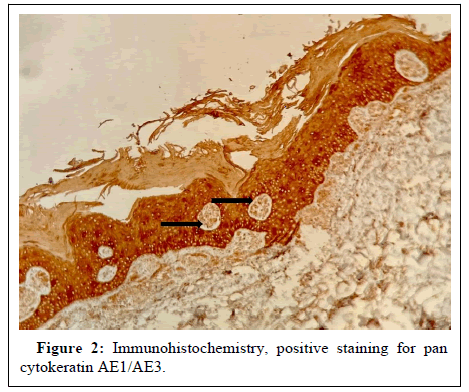Localized Cutaneous Amyloidosis Revealed by Immunohistochemistry: An Interesting Diagnostic Tool
Received: 09-Mar-2022 / Manuscript No. JCEP-22-56584 / Editor assigned: 11-Mar-2022 / PreQC No. JCEP-22-56584 (PQ) / Reviewed: 01-Apr-2022 / QC No. JCEP-22-56584 / Revised: 08-Apr-2022 / Manuscript No. JCEP-22-56584 (R) / Published Date: 15-Apr-2022 DOI: 10.4172/2161-0681.1000002
Keywords: cytokeratin, Localised Cutaneous Amyloidosis
Case Description
An 85-year-old woman had a lightly pruritic firm plaque on the forearm for 28 years. She had no major medical trouble and she didn’t receive any medical treatment before visiting dermatology’s department. Biopsy specimen from the lesion revealed an amorphous acellular eosinophilic deposit (black star) in the papillary dermis (Figures 1A and 1B). The overlying epidermis was of normal thickness without hyperkeratosis. The deposits were negative for Congo red staining (Figure 1C), without typical green birefrengence on polarizing microscopy (Figure 1D). On immunohistochemistry, they stained diffusely positive with pan cytokeratin AE1/AE3 (Figure 2).
Localised Cutaneous Amyloidosis (LCA) is defined by the deposition of amyloid in the skin with the absence of systemic involvement [1]. LCA can be divided into: primary and secondary LCA [1]. The latter, is observed in several inflammatory and neoplastic skin disordes such as seborrheic keratosis, Bowen’s disease and basal cell carcinoma [1,2]. Primary cutaneous amyloid is a chronic pruritic condition [1]. On histology, PCA shows amorphous eosinophilic deposits in the papillary dermis. Definite diagnosis requires special stains and sometimes immnohistochemistry [3] Amyloid is usually positive with Congo red staining; and shows green birefringence in polarizing microscopy. However, Cong red staining might be negative; as in the present case. Immunohistochemistry for cytokeratins (high molecular weight cytokeratins and ck 5/6) represents a useful diagnostic tool in LCA, because Congo red staining may not detect small deposits. In the study of et al., the authors recommend performing IHC for high molecular weight cytokeratins to exclude the diagnosis, when Congo red is negative [4]. These findings confirm the origin of amyloid: epidermal keratins due to epidermal long term damage [3].
References
- Aslani FS, Kargar H, Safaei A, Jowkar F, Hosseini M, et al. (2020) Comparison of immunostaining with hematoxylin-eosin and special stains in the diagnosis of cutaneous macular amyloidosis. Cureus 12: e7606.
[Crossref] [Google Scholar](all versions) [PubMed]
- Chang YT, Liu HN, Wang WJ, Lee DD, Tsai SF (2004) A study of cytokeratin profiles in localized cutaneous amyloids. Arch Dermatol 296:83-8.
[Crossref] [Google Scholar] [PubMed]
- Izumi K, Arita K, Horie K, Hoshina D, Shimizu H (2014) Localized cutaneous amyloidosis associated with poikilodermatous mycosis fungoides. Acta dermato-venereologica 94:225-6.
[Google Scholar] (all versions) [PubMed]
- Abdullah AA, Abdulgader FA (2015) The utility of congo red stain and cytokeratin immunostain in the detection of primary cutaneous amyloidosis. Internet J Pathol 17:1-7.
Citation: Sabrine D, Amine EM, Abderrahim E (2022) Localized Cutaneous Amyloidosis Revealed by Immunohistochemistry : An Interesting Diagnostic Tool. J Clin Exp Pathol S1:002. DOI: 10.4172/2161-0681.1000002
Copyright: © 2022 Sabrine D, et al. This is an open-access article distributed under the terms of the Creative Commons Attribution License, which permits unrestricted use, distribution, and reproduction in any medium, provided the original author and source are credited.
Select your language of interest to view the total content in your interested language
Share This Article
Recommended Journals
Open Access Journals
Article Tools
Article Usage
- Total views: 2057
- [From(publication date): 0-2022 - Oct 19, 2025]
- Breakdown by view type
- HTML page views: 1523
- PDF downloads: 534


